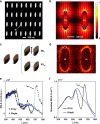Nanoscale mapping of optically inaccessible bound-states-in-the-continuum
- PMID: 35058424
- PMCID: PMC8776833
- DOI: 10.1038/s41377-021-00707-2
Nanoscale mapping of optically inaccessible bound-states-in-the-continuum
Abstract
Bound-states-in-the-continuum (BIC) is an emerging concept in nanophotonics with potential impact in applications, such as hyperspectral imaging, mirror-less lasing, and nonlinear harmonic generation. As true BIC modes are non-radiative, they cannot be excited by using propagating light to investigate their optical characteristics. In this paper, for the 1st time, we map out the strong near-field localization of the true BIC resonance on arrays of silicon nanoantennas, via electron energy loss spectroscopy with a sub-1-nm electron beam. By systematically breaking the designed antenna symmetry, emissive quasi-BIC resonances become visible. This gives a unique experimental tool to determine the coherent interaction length, which we show to require at least six neighboring antenna elements. More importantly, we demonstrate that quasi-BIC resonances are able to enhance localized light emission via the Purcell effect by at least 60 times, as compared to unpatterned silicon. This work is expected to enable practical applications of designed, ultra-compact BIC antennas such as for the controlled, localized excitation of quantum emitters.
© 2022. The Author(s).
Conflict of interest statement
The authors declare no competing interests.
Figures




References
-
- von Neumann J, Wigner EP. Über merkwürdige diskrete Eigenwerte. Physikalische Z. 1929;30:465–467.
-
- Capasso F, et al. Observation of an electronic bound state above a potential well. Nature. 1992;358:565–567.
-
- Herrick DR. Construction of bound states in the continuum for epitaxial heterostructure superlattices. Phys. B+C. 1976;85:44–50.
-
- Stillinger FH. Potentials supporting positive-energy eigenstates and their application to semiconductor heterostructures. Phys. B+C. 1976;85:270–276.
-
- Parker R. Resonance effects in wake shedding from parallel plates: some experimental observations. J. Sound Vib. 1966;4:62–72.
Grants and funding
- 1527300025/A*STAR | Science and Engineering Research Council (Science and Engineering Research Council - A STAR)
- 1527300025/A*STAR | Science and Engineering Research Council (Science and Engineering Research Council - A STAR)
- A20E5c0093/Agency for Science, Technology and Research (A*STAR)
- 202D8088/Agency for Science, Technology and Research (A*STAR)
- NRF-CRP20-2017-0001/National Research Foundation Singapore (National Research Foundation-Prime Minister's office, Republic of Singapore)
LinkOut - more resources
Full Text Sources
Research Materials

